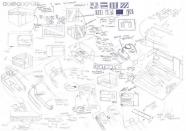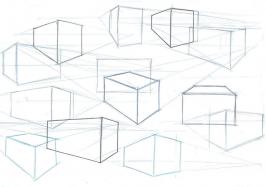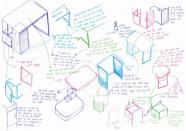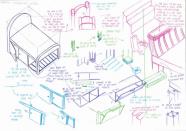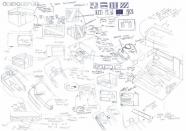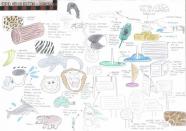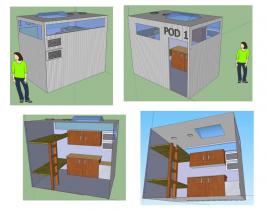Sketching techniques in DVC
Design and Visual Communication (DVC) teachers at Rangitoto College have developed some new strategies to improve the dynamism and effectiveness within their students' sketching techniques.
Making change
Rangitoto College, New Zealand's biggest secondary school, has a roll of approximately 3,000 students, which includes a large intake of international students. The Technology department has six teachers who teach DVC from Year 9–13. Curriculum leader – DVC Mark Foster says they were concerned that there was a tendency for students to sketch as a series of stages (concepts and development sketches) rather than use more dynamic sketching techniques.
Mark and his colleagues have been revising and developing their schemes of work. This has involved reviewing teaching and learning related to technical and presentation sketching in order to refine the programme and improve standards.
As part of the review, teachers considered their students' sketching techniques. Mark notes that many of the international students who join a DVC class are very 'tight' in their approach to sketching. "They find it hard to express themselves visually without a tightly defined framework. It can be quite challenging at first, getting these students to loosen up and feel confident enough to explore their thinking and responses through visual means". In response to this, teachers used activities from their junior programmes to help these students "get up to speed" with the rest of the class.
Mark had noticed that many students produced concept drawings which were neatly laid out in sections of the paper with annotations organised in lines alongside (or sometimes typed up and pasted next to the drawing). He cites the example below, noting that the student clearly has some great ideas for her clock design and is communicating them through a series of confident, rendered drawings. "However, like many of her peers, she is missing the earlier stages of visual thinking".
Mark was keen to encourage students to make more extensive use of dynamic sketching techniques and felt that this might also reduce the need for excessive annotation at the expense of visual communication. He points out that even talented students in senior classes were drawing with a very "wooden" approach, as illustrated in this Level 2 example of designs for a cell phone.
In comparison, a later example of explorative sketches for a packaging design by a Year 10 student indicates that junior students are progressing in the direction Mark and his colleagues envisaged.
Strategies
The DVC team has been working on a number of strategies to change students' approach to design sketching. Initially, their efforts were "top down", focussing on Level 2 and 3 students. Mark explains that they wanted these students to produce a visual response to their brief which involved more dynamic sketching techniques. "We also believed that if they were able to visualise more spontaneously it would be of benefit to them if they moved on to tertiary level design courses. At first it was hard work getting these senior students to loosen up but we have made good progress and many of them commented on how much more confident they felt when putting pencil to paper".
This sheet of rapid visualisation of ideas for a sports accessory product, from a Level 2 student, illustrates what teachers had been trying to achieve. She moved on to identifying potential concepts and developed them further with explorative and thinking sketches. "It is evident that the boundaries between these stages of Graphics practice are becoming more blurred – something we are encouraging".
At Level 2 and 3, Mark says, the confident and dynamic approach they are looking for is really starting to emerge amongst the majority of students. "As we build up our resources of exemplars and focussed drawing activities, we think this process will continue in the right direction".
The foundation for what the team is trying to achieve is, of course, the junior classes, and more observational sketching activities have been incorporated into the Year 9/10 programme. "This type of activity needs to continue with senior classes and we are currently planning how this will fit into the NCEA courses. There is evidence of more dynamic sketching in the latter, but we would like it to go further".
The draft Technology learning objectives gave a clear indication of progression with visual communication, and were a useful baseline for team planning.
| Standards | Level 6 | Level 7 | Level 8 |
| Visual Communication | Demonstrate skills in, and understanding of, fundamental drawing techniques to present visual information | Demonstrate understanding of and skills in drawing techniques to communicate complex and detailed visual information | *Demonstrate skills in, and an understanding of, organising visual information for effective presentation |
Mark points out that the strategies the team developed also addressed specific key competencies in The New Zealand Curriculum: Thinking is about using creative, critical and metacognitive processes to make sense of information, experiences and ideas. These processes can be applied to purposes such as developing understanding, making decisions, shaping actions, or constructing knowledge. Intellectual curiosity is at the heart of this competency.
Sketching resources
Over several years, the team made up class sets of objects that could be used as a drawing resource for junior students. The choice of objects varied so that teachers could focus students' observations on a range of visual elements. "Many of these types of sketching activities are excellent for warm-up sessions, and teachers are beginning to pepper them throughout the programme so that students keep returning to the basics and building up their basic visual communication skills".
Teachers also use photographs, shown on an interactive whiteboard, to help students 'look' in a way that further informs their visual knowledge and understanding. Mark says that using the whiteboard enables discussion and engages students in the process of observation. Having gained better looking and thinking skills, students are more likely to translate this into sketching that will give them the confidence to explore their own ideas in response to a brief.
In another activity, students are shown a sheet of sketches (also displayed on the whiteboard) and asked "What is being visually communicated by these sketches?". They are encouraged to call out comments about what they think the information communicates and the teacher records these on the whiteboard. The result, says Mark, is a 'thinking together' visual brainstorm, and the evidence can be saved for future reference.
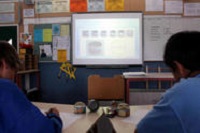
Students sketching. |
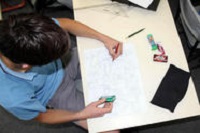
Abstract sketching 1. |
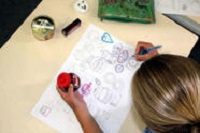
Abstract sketching 2. |
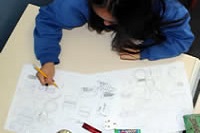
Abstract sketching 3. |
As the students start work on their own sketching, the teacher encourages and informs them while "trying to keep the pace up". "With lots of looking, thinking, and doing going on, the learning is very active!" Mark says. He adds that this type of exercise is also a useful tool for assessing the ability levels of students – individual responses can help identify which students may need additional support.
- Example dialogue (PDF file, 12kb)
- Student sketch
- Student sketching - 1
- Student sketching - 2
In order to give junior students some idea of progression within DVC and to set a standard for them to aim for, teachers show them an extensive collection of NCEA exemplars.
They are continuing to develop a range of activities, with the expectation that they are increasingly likely to see Level 1 assignments in which students are confidently sketching across a wide range of contexts.
Progress
A Year 11 student, given a brief which asked her to design a piece of furniture for a teenager's bedroom first explored her ideas using rapid visualisation sketching.
Throughout the first stage of the assignment the teacher encouraged the class with comments such as "Keep it loose. Don't get bogged down with too much detail. Let your first thoughts follow on to the paper." This student went on to select and develop her ideas using thinking sketches, "The sketching techniques are still quick and expressive though".
Mark explains that the transition to the use of thinking sketches isn't strict so, over a period of lessons, students will move at their own pace and their ideas will become more selectively developed.
As he considers the changes they have made, Mark concludes that perhaps in the past teachers were too rigid in insisting that students created their sketches using a range of modes such as oblique, isometric and perspective. "Now, we are confident that evidence of these techniques will occur naturally through the process of visual exploration. We believe this is confirmation that more students are gaining confidence in their ability to express themselves visually, selecting appropriate modes to do so."
The following examples of Year 10 work show a range of visual communication techniques used to communicate ideas and outcomes for a shipping container accommodation pod. Students used a large range of informal and formal sketching and drawing activities for this assignment. They were able to understand the relevance of working in the correct proportions through sketching of basic forms in perspective, and this gave them 'ready-made templates' that they could trace from once they started designing concepts. Doing explorative sketches enabled students to develop some ideas. Teaching of formal planometric and isometric drawing was included, with students learning about using appropriate scales, while their development of ideas towards final presentations also involved the use of Google SketchUp.
What Next?
In looking to the future, Mark and his team are conscious of the need to consider the impact of students bringing their own digital devices into the classroom. This will involve developing programmes of work that make best use of the opportunities these technologies present. Students already use programs such as Google SketchUp as a drawing tool but teachers are aware that with technology developing so rapidly they will need to "be on our toes" to keep up with students.
He notes that he and his team found the resources below very useful for supporting teaching and learning related to sketching.
Books
- Creating Dynamic Roughs – Alan Swann, North Light Books ISBN 0891342885
- Sketching: Drawing Techniques for Product Designers – Koos Eissen/Roselien Steur, Page One Publishing, ISBN 9789812456212


